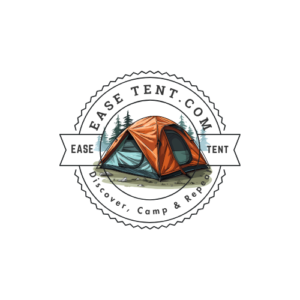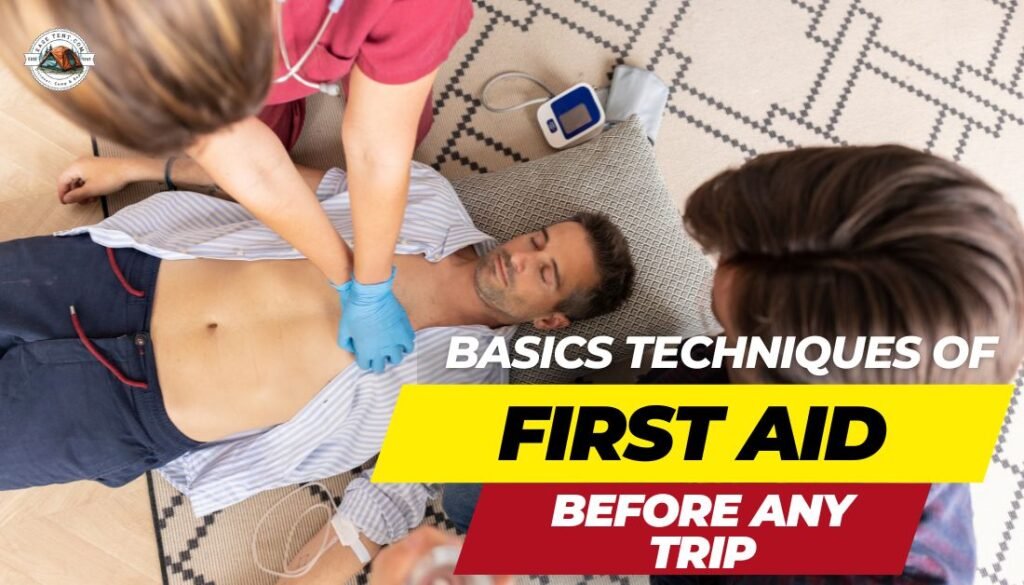When you’re out in the wild, a lot of unexpected things can happen—and it usually does when you’re least prepared. Whether it’s a scraped knee on a hike, a sudden allergic reaction, or something more serious, having the right first aid knowledge and supplies can make all the difference. Let’s face it, in the middle of nature, far from hospitals and cell service, you’re your own first responder.
In this guide, we’ll discuss the camping first aid basics that every camper needs to know, from handling emergencies like major bleeding or choking to packing a first aid kit that covers all bases.
Being prepared doesn’t just keep the trip fun—it can save lives.
Table of Contents
Why First Aid Knowledge is Crucial for Campers.
You never really think about it until you’re in the middle of nowhere, right? However, having some knowledge about first aid can be a real lifesaver in accidental conditions. Imagine you’re out on a hike, enjoying the fresh air, and suddenly you trip and scrape your knee, or worse, twist an ankle. Having basic first aid awareness can help you handle those situations calmly and effectively. It can mean the difference between a small, manageable injury and something much more serious.
Camping takes you away from the conveniences of modern life—like being able to pop over to a hospital or call an ambulance in minutes. So, if something goes wrong, you’re pretty much on your own until help arrives. That’s why understanding basic first aid, like cleaning a wound, treating a burn, or stopping a nosebleed, is crucial. It gives you confidence and peace of mind, and, most importantly, can help you stay safe when you’re out in the wild.
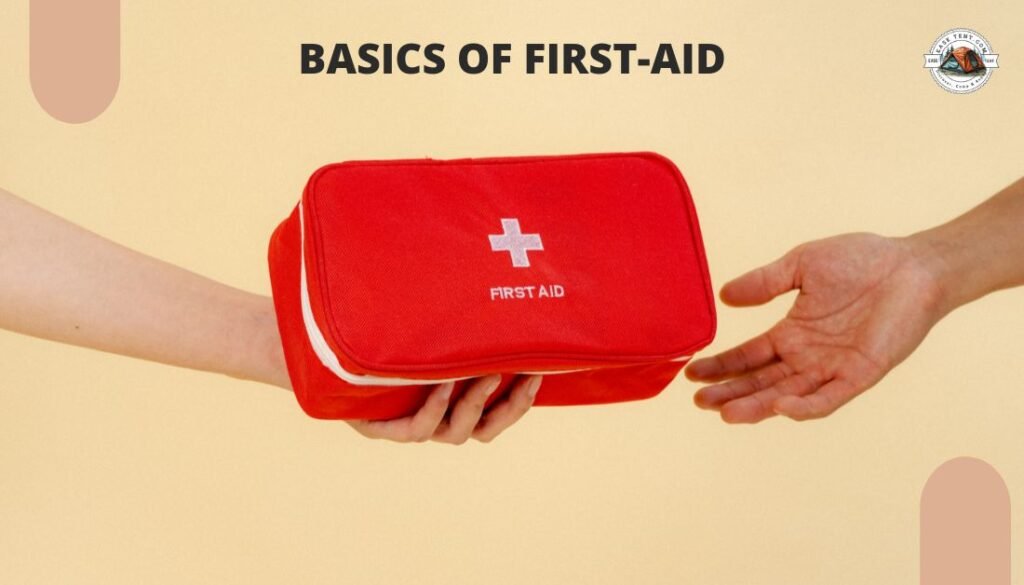
Common Outdoor Scenarios requiring First Aid
There are a few camping injuries that require first aid and that can quickly go from fun to serious if you’re not prepared. Nature is beautiful, but it can be unpredictable.
Here are some of the most common outdoor scenarios where first aid knowledge comes in handy:
Cuts and Scrapes
Whether you’re setting up camp, cooking, or exploring the trail, it’s easy to get nicked by a branch, rock, or even your own gear. These small cuts might seem insignificant, but if left untreated, they can get infected, especially in the wilderness where bacteria are everywhere.
Sprains and Strains
Hiking on uneven terrain or carrying heavy gear can easily lead to twisted ankles or strained muscles. If you’re not careful, this can ruin your trip. Knowing how to wrap an injury, elevate it, and manage pain can make all the difference.
Burns
Cooking over a campfire or using a stove can result in burns, especially if you’re not paying attention. These injuries can be painful and, if severe, dangerous. A little knowledge on how to treat burns with cool water and burn gel can prevent a painful situation from becoming a nightmare.
Insect Bites and Stings
let’s be honest—mosquitoes and bees are everywhere when you’re outdoors. While most bites are harmless, some can lead to allergic reactions or worse. Knowing how to manage the swelling and when to seek medical help can help you stay safe and comfortable.
Heat Exhaustion and Dehydration
On a hot day, you might not realize how quickly dehydration or heat exhaustion can set in. The last thing you want is to feel dizzy or faint in the middle of nowhere. Knowing the signs and how to cool down or rehydrate can save you from becoming seriously ill.
Hypothermia and Frostbite
if you’re camping in colder conditions, hypothermia and frostbite are real risks. A sudden drop in temperature, wet clothes, or not having enough warmth can lead to these dangerous conditions. Understanding how to recognize the symptoms and take action can prevent these cold-weather hazards from turning deadly.
What should be in your Camping First Aid Kit?
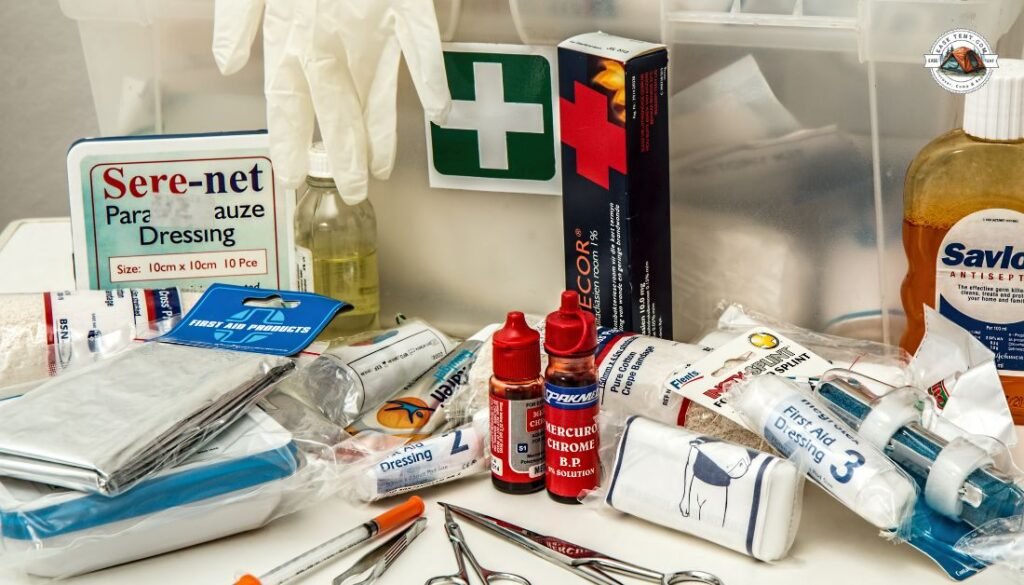
Every time I upload a reel on my Instagram page, I get so many comments—about 30% of them ask, ‘What first aid supplies should we pack for a camping trip?’ So, here are the must-have items you should definitely include in your first aid kit.
| Item | Uses |
|---|
| Bandages and Gauze Pads | Used to cover cuts, scrapes, or blisters. Helps prevent dirt from entering wounds and promotes healing. Available in various sizes for different types of injuries. |
| Antiseptic Wipes or Solution | Cleans wounds to prevent infection. Essential for cleaning cuts, scrapes, and other skin injuries before applying bandages. |
| Tweezers | Used to remove splinters, ticks, or other foreign objects from the skin. Helps to do this without causing additional damage or infection. |
| Adhesive Tape and Elastic Bandage | Secures bandages or gauze in place. Elastic bandages are also useful for stabilizing sprained or strained joints, keeping them immobilized until further care. |
| Burn Gel or Aloe Vera | Soothes burns, including sunburn or burns from campfires. Helps reduce pain, prevent infection, and support healing. |
| Pain Relievers (Ibuprofen, Acetaminophen) | Helps alleviate headaches, muscle pain, or inflammation. Useful for treating common camping discomforts. |
| Antihistamines (Benadryl or similar) | Used to treat allergic reactions, especially from insect bites or exposure to plants like poison ivy. Helps reduce swelling and itching. |
| Scissors | Used to cut tape, gauze, or clothing. Can be helpful for making makeshift slings or cutting bandages to the correct size. |
| Thermometer | Used to check for fever, especially in cases of infection or heat-related illness. Helps monitor the health of anyone in distress. |
| CPR Face Shield or Mask | Protects both the rescuer and the injured person during CPR. Ensures safe, hygienic resuscitation in case of an emergency. |
| Instant Cold Packs | Provides immediate relief for swelling, bruises, or sprains. Great for reducing inflammation and numbing the pain on the go. |
| Emergency Blanket | Used to retain body heat in case of hypothermia or exposure to cold conditions. Lightweight and compact for easy storage. |
Key First Aid Techniques for Common Camping Injuries
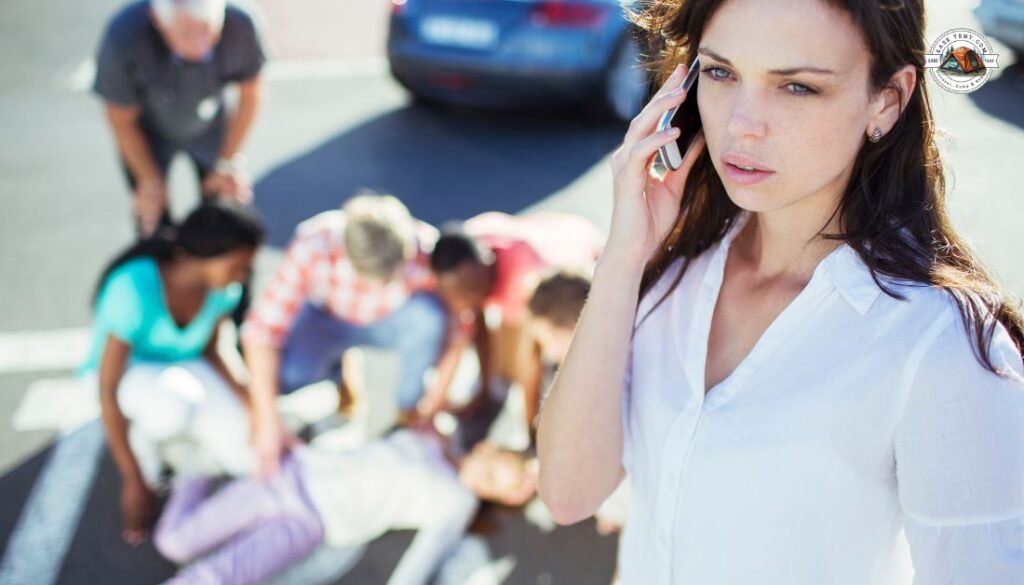
When you’re camping, accidents can happen, and it’s important to know how to handle them. Here are some key first-aid techniques for common camping injuries that can make all the difference:
Treating Cuts and Scrapes
What to do
- Clean the wound with water and an antiseptic wipe or solution to remove any dirt or debris.
- Apply a sterile bandage or gauze pad to cover the wound and stop any bleeding.
- If the cut is deep or won’t stop bleeding, apply pressure and elevate the area if possible. Seek medical attention if necessary.
Why it matters
you never know when a tiny cut could get infected, especially out in the wild. Cleaning and covering it helps prevent bacteria from entering and keeps you safe.
Managing Sprains and Strains
What to do
- Rest the injured area to avoid further damage.
- Apply ice or a cold pack to reduce swelling and numb the pain (20 minutes on, 20 minutes off).
- Compress the injury with an elastic bandage to stabilize it.
- Elevate the injured area to reduce swelling.
- If the pain is severe or you suspect a fracture, get medical help immediately.
Why it matters
Sprains and strains are common when you’re hiking or climbing. Proper treatment helps reduce swelling, minimizes pain, and prevents the injury from getting worse.
Burn Treatment
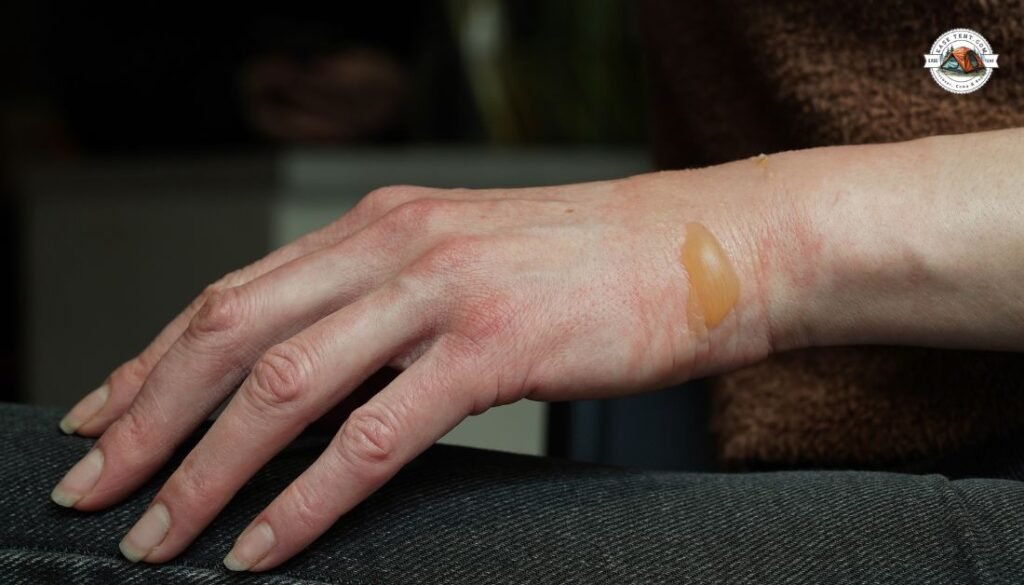
What to do
- For minor burns (from the sun, campfire, or stove), run the area under cool water for several minutes to stop the burning process.
- Apply burn gel or aloe Vera to soothe the skin and reduce pain.
- Cover the burn with a sterile bandage or gauze, but don’t put too much pressure on it.
- For severe burns, especially if skin blisters or turns white, seek immediate medical help.
Why it matters
Burns can escalate quickly if not treated properly. Cooling the burn and soothing it with the right gel can reduce the risk of complications and speed up recovery.
Dealing with Insect Bites and Stings
What to do
- Clean the bite or sting area with an antiseptic wipe to prevent infection.
- Apply an antihistamine or anti-itch cream to reduce swelling and itching.
- If the sting is from a bee, remove the stinger carefully using tweezers.
- In case of severe allergic reactions (like swelling of the face or difficulty breathing), administer an epinephrine shot if available and seek emergency medical care immediately.
Why it matters
While most bites and stings are harmless, some can cause allergic reactions or infections. Knowing how to handle them quickly prevents discomfort and more serious issues.
Recognizing and Treating Dehydration and Heat Exhaustion
What to do
- If you or someone else feels dizzy, weak, or nauseous, get to a shaded area and drink water slowly. Avoid sugary or caffeinated drinks.
- If heat exhaustion is suspected, cool the person down with wet clothes, a cold compress, or a fan.
- Have them rest and rehydrate with small sips of water.
- If the symptoms don’t improve or worsen, seek medical attention for heat stroke.
Why it matters
Dehydration and heat exhaustion can sneak up on you, especially on hot days. If not treated quickly, they can become life-threatening, but with prompt action, you can recover quickly.
Hypothermia and Frostbite Treatment
What to do
- If someone shows signs of hypothermia (shivering, confusion, slurred speech), get them to a warmer environment and remove any wet clothes.
- Slowly warm them up by covering them with blankets, using warm (not hot) water bottles, or sharing body heat.
- For frostbite (numbness, pale or waxy skin), gently rewarm the affected area in warm water (not directly on a heat source).
- Never rub frostbitten areas, as it can cause further damage.
- Seek immediate medical help for severe cases.
Why it matters
Cold weather injuries like hypothermia and frostbite are serious, and without prompt treatment, they can cause permanent damage. Acting quickly can prevent further harm and save lives.
Emergency Response for Severe Situations
When you’re camping, sometimes severe situations can arise, and how you respond in those critical moments can make all the difference.
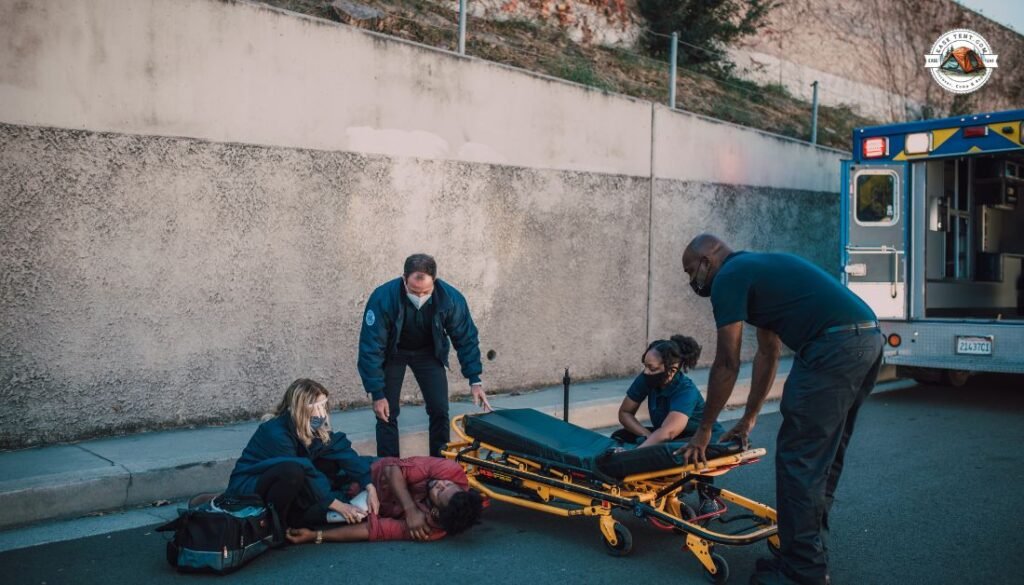
Here’s how to handle some of the more serious emergencies that might happen in the wild:
Snake Bites
What to do
- The first thing is not to panic, as this can make the situation worse.
- Keep the bite area still and below the heart to slow down the spread of venom.
- Clean the bite gently with water (but don’t try to suck out the venom).
- Get medical help immediately—snake venom acts quickly, and you’ll need antivenom to neutralize it. Call for help or head to the nearest medical facility.
- Try to identify the snake if it’s safe to do so, as knowing whether it’s venomous can help emergency responders provide the right treatment.
Why it matters
Snake bites can be life-threatening, especially if the snake is venomous. Quick action can reduce the severity of the bite and increase your chances of recovery.
Severe Allergic Reactions (Anaphylaxis)
What to do
- Use an epinephrine auto-injector (EpiPen) immediately if you have one.
- Call for medical help—anaphylaxis can progress quickly, so getting professional care is critical.
- Keep the person calm and still, as activity can worsen the reaction.
- If the person is struggling to breathe or losing consciousness, perform CPR if trained to do so.
Why it matters
Anaphylactic reactions can cause swelling, difficulty breathing, and a drop in blood pressure. Without prompt treatment, it can be fatal, so having an epinephrine injector on hand can save a life.
Severe Bleeding
What to do
- Apply direct pressure to the wound using a clean cloth or your hands.
- If bleeding is severe, elevate the injured area to slow down the blood flow.
- Use a tourniquet only if the bleeding is uncontrollable and the wound is on a limb (use it above the injury site).
- Keep pressure on the wound until help arrives. If the bleeding doesn’t stop after 10 minutes of pressure, it’s time to seek professional help.
Why it matters
Severe bleeding can quickly lead to shock, so stopping the blood loss is your first priority. Quick action can prevent life-threatening situations.
Heart Attack
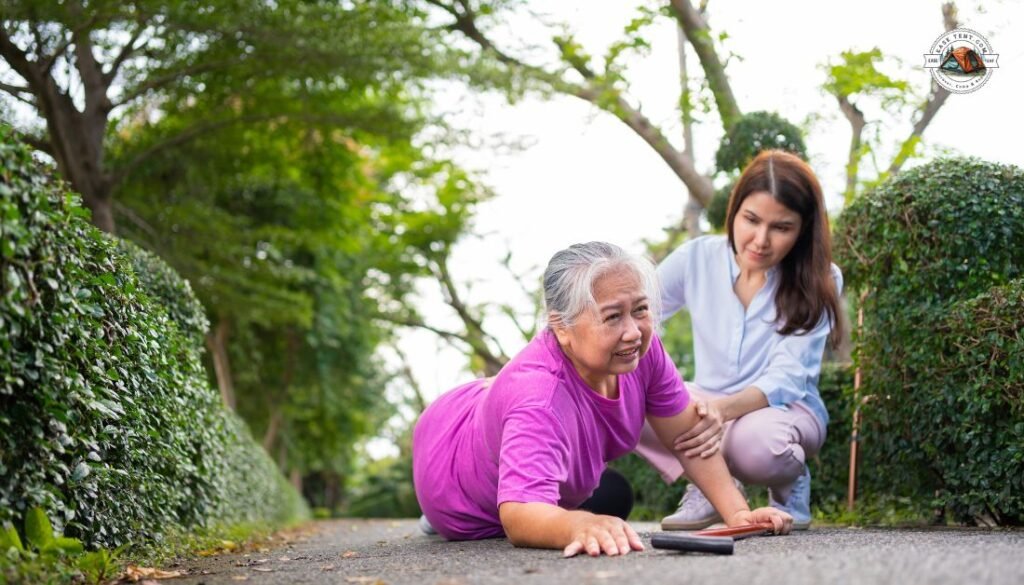
What to do
- Call for emergency help immediately. Time is critical when someone’s heart is in distress.
- Keep the person calm and still—stress can make the situation worse.
- If the person is conscious, have them chew aspirin (unless they’re allergic).
- Perform CPR if the person stops breathing and you are trained to do so.
- Use an automated external defibrillator (AED) if available and follow the instructions.
Why it matters
A heart attack can lead to cardiac arrest if not addressed right away. Knowing CPR and having access to an AED can significantly improve the chances of survival.
Drowning or Water-Related Accidents
What to do
- Rescue the person from the water as safely as possible. If they’re unconscious, you’ll need to act fast, but don’t put yourself at risk.
- Check for breathing—if the person isn’t breathing, start CPR immediately.
- Keep the airway open and continue CPR until help arrives or the person starts breathing again.
- Call for medical assistance—even if the person seems okay after being rescued, they may have inhaled water and need medical attention.
Why it matters
Drowning doesn’t always look like the dramatic splashing you see in movies. Someone may appear calm but can be struggling internally. Immediate action is critical.
Severe Burns
What to do
- For third-degree burns (skin is charred or leathery), cover the burn with a clean cloth to protect it from infection, but don’t try to remove burnt clothing.
- Don’t apply water to severe burns—it can make things worse.
- Call for emergency help immediately, as severe burns can lead to shock or infections.
- Monitor for signs of shock, such as pale skin, rapid breathing, or confusion, and lay the person down with their feet elevated.
Why it matters
Severe burns can cause permanent damage and may lead to infections or shock. Fast, proper care can minimize damage and save the person’s life.
Hypothermia
What to do
- Move the person to a warmer place and remove any wet clothing.
- Warm them slowly—use blankets, warm (not hot) water bottles, or body heat to gradually increase their body temperature.
- Give warm, non-alcoholic drinks if the person is alert.
- Monitor breathing and pulse—if they stop, begin CPR.
- Seek medical help immediately.
Why it matters
Hypothermia is deadly if not treated quickly. Gradual warming is essential—too much heat too fast can cause shock. Proper care is key to saving a person’s life.
Preventative Measures to Avoid Injuries
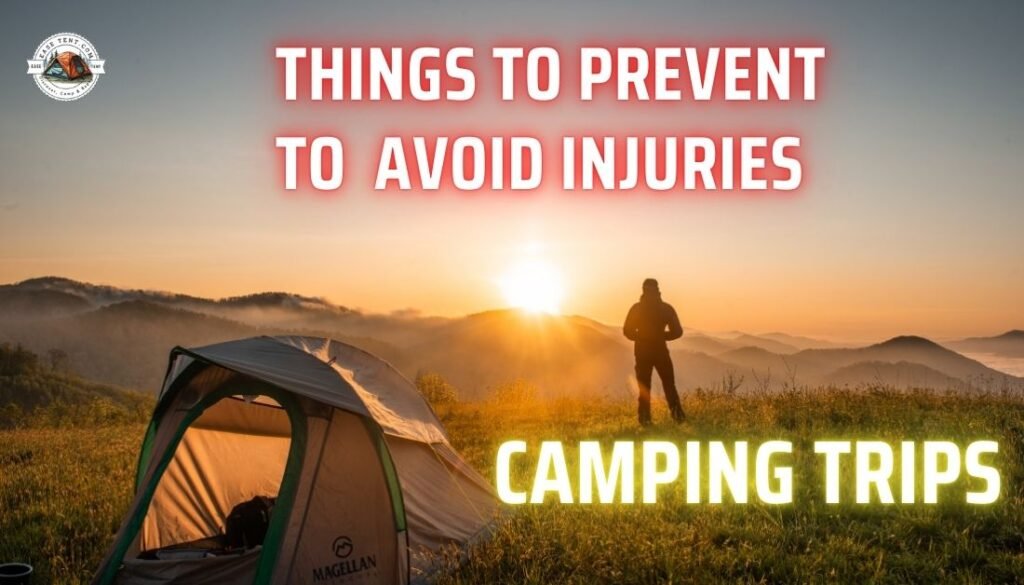
The best way to deal with injuries is to avoid them in the first place. I know it sounds like an obvious thing to say, but trust me—preventing injuries can save you a lot of stress, pain, and even potential danger. So, let’s talk about some simple preventative measures you can take to make sure your camping trip stays fun and safe!
Wear Proper Footwear
Why it matters
Think about how many miles you’re going to walk and hike. If you’re wearing the wrong shoes—like flip-flops or old sneakers—you could end up with blisters, sore feet, or worse, twisted ankles.
What to do
Invest in a good pair of hiking boots that are sturdy, comfortable, and fit well. When you’re hiking on uneven terrain or through the woods, your feet need proper support. It’s the foundation of every step you take! A solid pair of boots will prevent foot fatigue, and blisters, and give you the support needed for those long treks. Don’t skip this one!
Use Sunscreen and Protective Clothing
Why it matters
You might think, “It’s just a little sunshine,” but overexposure can lead to burns, heatstroke, or worse, long-term skin damage. You don’t want to spend the rest of your trip in pain or dealing with a sunburn that’s more red than you are!
What to do
Before heading out, apply a broad-spectrum sunscreen (SPF 30 or higher) to any exposed skin. And, if you can, wear a hat and protective clothing like long sleeves to reduce sun exposure. You don’t need to look like a fashion model in the wilderness—just keep yourself safe. Reapply sunscreen every couple of hours, especially if you’re sweating or swimming.
Stay Hydrated
Why it matters
Dehydration can sneak up on you, especially when you’re hiking or spending hours outside. It can cause headaches, and dizziness, and even lead to more serious issues like heat exhaustion. You might not realize you’re getting dehydrated until it’s too late.
What to do
Keep a water bottle on you at all times. Try to drink regularly, even if you’re not feeling thirsty. A good rule of thumb is to drink about 2 liters of water a day (more if you’re hiking in hot weather). It’s not just about staying cool; it’s about keeping your energy up and your body functioning at its best.
Keep Your Campsite Safe
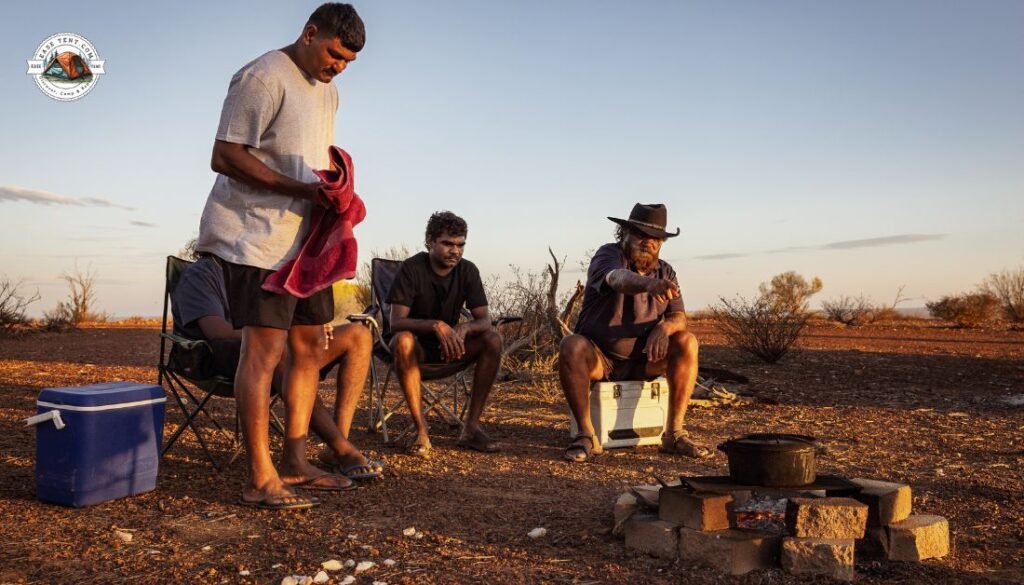
Why it matters
The place where you set up camp is just as important as what you bring. Tripping over a tent peg or cutting yourself on a sharp rock can happen faster than you think, especially in the dark.
What to do
Set up your tent on level ground, away from sharp objects, rocks, or tree roots that could cause tripping. Keep your campsite tidy and clear any potential hazards, like loose ropes or firewood that could roll. Simple steps like this will reduce your risk of injuries, and you’ll feel more relaxed, knowing everything’s safe.
Practice Good Fire Safety
Why it matters
Fires are great for warmth, cooking, and ambiance, but they’re also one of the most common causes of camping injuries. A small spark can quickly get out of control, especially in dry conditions.
What to do
Always keep your fire contained within a fire ring or pit. Never leave it unattended, and make sure it’s completely out before leaving the area or going to bed. Having a water source or fire extinguisher nearby is always a good idea. And, when cooking, never lean over the campfire or leave hot coals unattended. That way, you can avoid burns and prevent accidental fires.
Know Your Terrain
Why it matters
Many camping injuries occur simply because people are unaware of their surroundings. Stepping on a snake, twisting an ankle on uneven ground, or getting too close to a cliff edge can all be avoided if you’re paying attention.
What to do
Take time to familiarize yourself with your campsite and surrounding area. If you’re hiking, stay on marked trails and avoid wandering off the path. Watch out for uneven surfaces, loose rocks, or sudden drops. If you’re unsure about certain areas, ask a park ranger or fellow campers about any dangers you should watch for. Knowing where you’re going can help you avoid unwanted surprises.
Be Mindful of Wildlife
Why it matters
Wild animals are unpredictable, and sometimes all it takes is a small mistake to cause a dangerous encounter. Bears, snakes, or even smaller creatures like raccoons can get into your food or cause harm if you’re not careful.
What to do
Always store food in bear-resistant containers or hang it up high if you’re in bear country. Be cautious when hiking, and make noise to alert animals of your presence (especially in areas with bears or mountain lions). Keep a safe distance from wildlife, and never approach or feed them. By respecting their space, you’ll stay safe—and so will they!
Know Basic First Aid
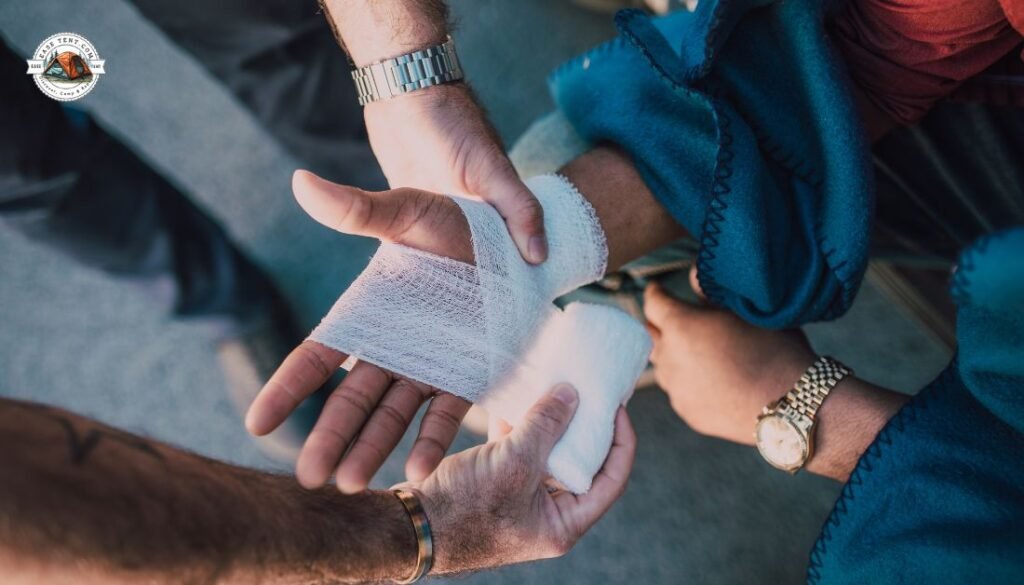
Why it matters
Even if you do everything right, accidents can still happen. A cut, a scrape, or a twisted ankle might seem small, but knowing how to deal with it can prevent it from becoming worse.
What to do
Familiarize yourself with the basics of first aid—how to treat cuts, how to handle sprains, how to recognize symptoms of heat exhaustion, and how to perform CPR. You don’t need to be an expert, but just knowing how to clean and dress a wound or apply pressure to a bleeding cut can make a big difference. Don’t forget to carry a well-stocked first aid kit!
Take Your Time and Rest
Why it matters
When you’re in nature, it’s easy to push yourself, especially if you’re excited to explore. But exhaustion can lead to mistakes, like tripping, falling, or not paying attention to your surroundings.
What to do
Make sure to take regular breaks during hikes, set up camp early, and get plenty of rest at night. The last thing you want is to push your body too hard, only to end up with fatigue-related injuries. Pace yourself, enjoy the journey, and give your body the time it needs to recharge.
Training and Resources
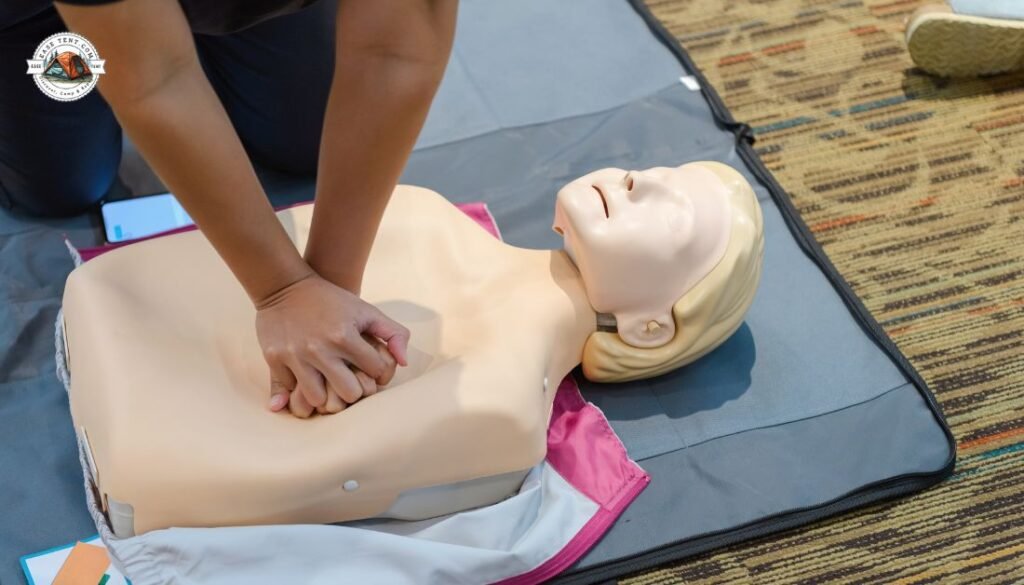
Training and resources are essential for anyone who enjoys camping, especially when it comes to first aid and emergency preparedness. Knowing what to do in a medical emergency can make all the difference, and having the right resources on hand can provide you with the confidence you need when faced with a challenging situation.
First Aid Training
Taking a first aid and CPR course is one of the best investments you can make as a camper. These courses teach you how to handle a wide range of injuries and emergencies, from cuts and bruises to more severe situations like heart attacks or choking. The American Red Cross and other organizations offer comprehensive courses that often include hands-on training and certification. Once you’re certified, you’ll have a solid understanding of how to react quickly and efficiently when someone needs help.
Online Resources
If you can’t attend an in-person course or just want to brush up on your skills, there are plenty of online resources that can be incredibly helpful. Websites like the American Red Cross, St. John Ambulance, and Wilderness Medical Society offer instructional videos, articles, and detailed guides on first aid techniques. These resources are accessible anytime, so you can quickly review essential skills right before you head out on your trip.
Camping Apps
In today’s digital age, there are also apps designed for camping and wilderness safety. Many of these apps guide you about camping first aid basics, and emergency contact information, even offline maps of your location. Some apps even have step-by-step instructions for treating specific injuries, and they can help you navigate to the nearest hospital or emergency services if needed. Make sure to download and familiarize yourself with at least one trusted app before you head into the wilderness.
Books and Field Guides
If you prefer a more traditional approach, many field guides and books cover wilderness first aid. These can be great to carry along with you, especially if you’re venturing into remote areas where the signal might be spotty. Books like “Wilderness Medicine” by William W. Forgey or “The Survival Medicine Handbook” by Joseph Alton provide in-depth, expert advice on handling medical emergencies in the wild. I’m sure that if you take the time to read these books, you’ll master the camping first aid basics and feel more prepared for anything that comes your way.
Practice and Repetition
Knowledge is important, but practicing your skills is just as vital. After learning first aid, regularly practicing techniques like CPR, wound care, or splinting is key to retaining your skills. Many first aid courses offer refresher courses or encourage regular practice so that your muscle memory is sharp when you need it most.
Local Support Networks
Before you head out, it’s also a good idea to connect with local groups, such as search and rescue teams or outdoor enthusiast communities. They can be great resources for learning about specific hazards in the area, tips for staying safe, and any emergency procedures unique to your location.
FAQs
What are the essential first steps for major bleeding, choking, or loss of breathing while camping?
For major bleeding, apply firm pressure with a clean cloth to stop the bleeding. For choking, perform the Heimlich maneuver or back blows if trained. If someone isn’t breathing, immediately start CPR and ensure their airway is clear.
When should I call emergency services for help with camping injuries?
Call emergency services if the injury is life-threatening, like severe bleeding, broken bones, or if someone is unconscious. Also, call if symptoms like chest pain, trouble breathing, or severe allergic reactions occur.
What should I do if someone has a severe allergic reaction while camping remotely?
Administer an epinephrine auto-injector (EpiPen) immediately if available, and call emergency services. Keep the person calm and lying down while monitoring their breathing and pulse until help arrives.
Conclusion
Camping is all about adventure, connection, and enjoying the beauty of nature—but safety should never take a backseat. By learning essential first aid skills and packing the right supplies, you’re not just protecting yourself but also looking out for your friends, family, and fellow campers.
Accidents can happen anywhere, but being prepared turns a crisis into a manageable situation. So, gear up, stay confident, and enjoy your outdoor adventures knowing you’re ready for whatever nature throws your way. Happy camping!
You May Also Like:
A Camper’s Guide to Identify and Avoid Poisonous Plants
